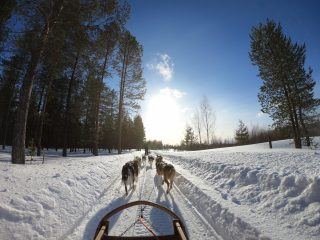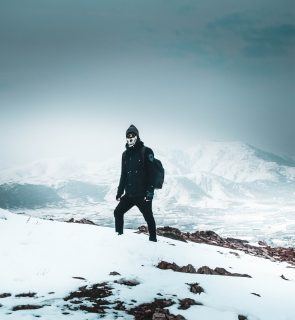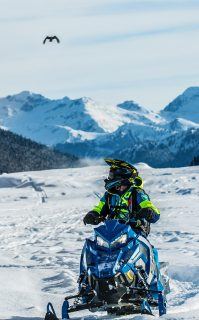A white blanket of fresh snow, there’s nothing better. But what can you do for exercise, especially if skiing or hardcore snow sports aren’t your thing? There’s no doubt that skiing is a brilliant winter sport. But what other different sports are there to try over the festive season when the snow starts to fall? Here are a few other options to get you out of the house and keep you active during this period. And of course, it’s a way to have an immense amount of fun in the snow. Some of these are easier to pick up than others. No matter which of them you choose, you’re pretty much guaranteed a good time.
Snowshoeing
When it snows, most people shy away from hiking. But, with a pair of snowshoes, you can explore the world of snow without spending a huge amount of money. Getting started with snowshoeing is fairly simple. Just a pair of shoes (which usually cost about $50), a few warm clothes, and a few hours of practice are all that’s needed to get started. Contiki recommends the majestic Austrian Tyrol.

Photo by Maël BALLAND from Pexels
Specifically, Hohe Tauern National Park where snowshoe trails wind through alpine hills and mountain huts up to Austria’s tallest peak, Grossglockner. With binoculars, you can spot ibex and even get lucky with binoculars. Plus, as Dominic Oliver mentions in his article for Contiki, you can leave massive footprints in the snow and pretend to be Bigfoot while exploring the area.
Skijoring and dog sledding
Being pulled along by a horse or dog while being pulled by a pair of skis is a thing. This is a sport that involves working together with a husky, who is often called a skijoring dog.

Photo by Lars Ley from Pexels
This Nordic sport originated in Scandinavia, but it has since become popular in North America where horses are used more frequently. Competitors race across four to six feet of snow while being pulled by a horse. As they go, they have to keep their balance while simultaneously avoiding the obstacles. Competitive races are anywhere between five and 20 kilometers long.
Dog sledding is a tradition that originated in Alaska. It involves using huskies to pull sleds through snowy landscapes. In dog sled racing, teams of sled dogs compete against each other to pull their dog driver, who is called ‘amusher’. Please do not use your own dog for this (even if it is a husky) as you may end up with an injured dog and thousands in vet fees. Rather leave it to the trained pups.
Fat biking
Bicycling in the winter might seem like an odd (or even impossible) thing to do. Especially if there’s snow involved. However, there is a way to get some cycling done even when the landscape is full of snow. Fat bikes are great for navigating through winter landscapes, as they allow riders to glide across uneven surfaces and rough terrains.

Photo by Suliman Sallehi from Pexels
They are designed to work seamlessly on snow, but look and feel like a normal bike. Fat biking is a great way to get around the snow-covered mountains without getting bogged down. Fat bike tours are great for winter travel, letting riders explore snow-covered mountain trails that would usually be impassable during the snowy, winter months.
Give mountaineering a go
If hiking in the winter just doesn’t seem difficult enough, you could always opt for some mountaineering instead. Winter mountaineering is a type of extreme hiking that typically involves conquering different terrains. It necessitates a lot of technical know-how and professional hiking gear in order to conquer the broad range of terrains covered in ice and snow.
Just hiking in snow is difficult enough. Mountaineering takes it up a gear. Even if you’re not afraid to venture out in the snow, you might be surprised by how challenging it is to get around Britain’s many hills. You can start with some smaller-scale hills in the UK or, if you’re experienced, try the iconic winter hiking trails up Glencoe and Ben Nevis.
Snowmobiles

Photo by Sebastian Voortman from Pexels
Probably one of the best-known ways to get around in the snow is the snowmobile. There are few experiences more exciting than riding a snowmobile through the snowy forests. If this is something that you’d like to attempt, it’s best to find a destination or company that offers snowmobile rentals.
If you haven’t done it before, you might also need a bit of practice before you go out on your own. Yellowstone National Park is home to some of the best snow for snowmobiling. This area features numerous trails and is considered to be the snowmobiling capital of the world.
Biathlons
To me, there seems to be no crazier winter sport than biathlons. The biathlon combines the skills of rifle shooting and cross-country skiing. The sport itself originated from traditions of survivalist societies in Scandinavian countries. It became an Olympic sport during the 20th century.
Biathlon involves a mixture of skiing and shooting at a target whilst standing or prone. It requires a combination of both mental and physical endurance. The objective is to complete the course in as fast a time as possible. If you’re new to biathlon, then getting started can be challenging. However, training can be done throughout the year usually with roller skis and tarmac.
References



![women [longevity live]](https://longevitylive.com/wp-content/uploads/2020/01/photo-of-women-walking-down-the-street-1116984-100x100.jpg)










